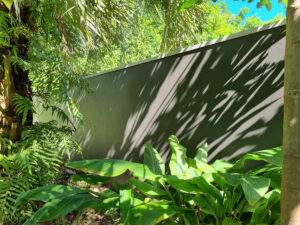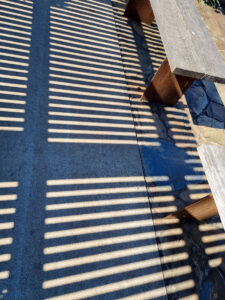
Shade and shadows
By Patrick Regnault
Shade and shadows are influential in the garden. The first one can be a blessing, cooling and restful, or challenging – what to plant and how to deal with it. The second one is easily overlooked, always changing and evolving as the day and seasons pass, creating ephemeral patterns that can be whimsical or sculptural. As designers, we can use both to our advantage.
Shade
In our climate, shade is very important as part of the building cooling system and as part of the garden design. We are all aware of the consequences of UV (ultraviolet) on our skin but we also need to consider heat stress, and with temperatures said to greatly increase, shade will become a necessity. A necessity not only for the people whose garden we are designing but also for the people looking after their gardens.
Trees are a large part of creating welcoming cool places. They shade the air and the soil, but not all shade trees are equal in their cooling effects. A Taiwanese study* done in 2007 shows that whole-tree foliage density, individual leaf colour, leaf thickness and leaf texture has significant effects on cooling the shaded air and soil.
In cooler climates deciduous trees are used to create shade in the hotter months, and in winter, lets the sun in. Tropical and subtropical areas have different requirements as the need for shade is greatly extended by comparison. Those hotter regions may require a distinct approach to shade, with a suite of shade tree types that will accommodate the needs depending on air temperature. Lighter shade trees for the warm season and denser shade trees for the hot season.
There is a very good palette of plants to use under shade trees, regardless of your location. The dense thick shade of some evergreens may require alternative solutions such as gravel which would suit a more formal sitting area, mulch and play equipment for the children, or pen and coop for the chickens.
There has always been a tendency to bring colour into shady areas and this often works. The reasoning behind it is has more to do with the subconscious fear of what lurks in shaded areas rather than the overlooked beauty they hold.

Shadows
Shadows and sun dapples can both be used to enhance the pleasure of a garden. They can come from plants or rocks, lets refer to them as natural shadows, or structures such as pergolas, swings, or fences which we will call structured shadows. They can be vertical or horizontal, or both, like the shadow of a deciduous tree cast simultaneously on the lawn and the wall of the house.
Natural shadows cast by plants are constantly changing depending on the wind force on the source of the shadow. The lighter the plant, the more dynamic the shadow will be. Take the shadow of Pennisetum rubrum cast on a wall compared to that of a Cordyline australis. This dynamismcan send a subliminal message to the visitor that can influence mood and lead to more animated social interactions. Too static and it can lead to a more sombre mood but if you get the balance just right it can be beautifully reflective, where a person can understand their place in time and space.
Structural shadows shift during the day as the earth rotates and the seasons change. Taking that into consideration, shadows can add a unique dimension to the design. The shadows of the closely spaced battens of a pergola will create a slowly changing pattern on walls or floors, creating a serene restful place where the creative juices flow. A perforated metal mesh wall or roof will create interesting patterns but can also be unsettling as they blur the vision and the sense of depth.
When we play with sun dapples, shadows, or shade in gardens, what we are truly doing is using the magic of light as shade and shadows are created by it. Designing that way adds depth to a garden but requires more planning time to achieve the desired effects.
* Lin, B., & Lin, Y. (2010). Cooling Effect of Shade Trees with Different Characteristics in a Subtropical Urban Park, HortScience horts, 45(1), 83-86. Retrieved Apr 29, 2023, from https://doi.org/10.21273/HORTSCI.45.1.83
Patrick Regnault FAIH RH0062
Interactive Landscapes
E: patrickregnault@hotmail.com
Main photo: Shadows and sun dapples can both be used to enhance the pleasure of a garden (Image: Patrick Regnault)
